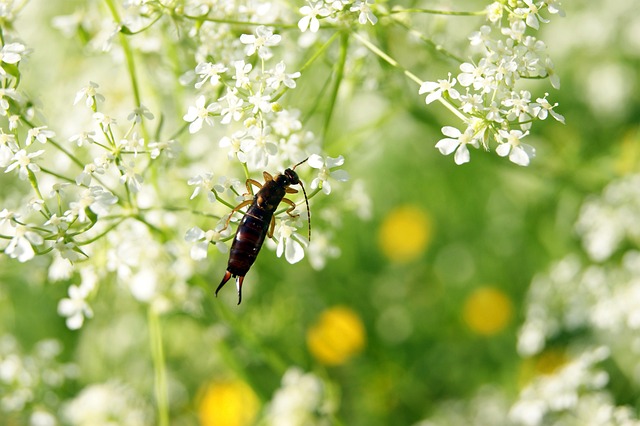Earwigs, nocturnal insects that thrive in damp, dark spaces, can infiltrate homes through cracks and plant material. Early detection is crucial for effective residential earwig treatment, which involves eliminating moisture, sealing entry points, and maintaining cleanliness. Non-chemical methods like sealing gaps, introducing natural predators, and IPM offer safer alternatives. Chemical treatments, such as insecticides, provide swift solutions but should be used sparingly due to potential health risks. Safety precautions include wearing protective gear and ensuring good ventilation during treatment. Regular inspections and maintenance afterward prevent reinfestation.
“Invasive earwigs can turn any home into a bustling enigma, leaving behind moist remnants and causing distress. This article offers a comprehensive guide to tackling severe earwig infestations in residential settings. We explore effective chemical treatments, detailing various options and safe application methods.
Beyond chemicals, non-chemical approaches are also discussed, providing an holistic strategy for earwig control. Remember that proper maintenance post-treatment is key to preventing future invasions. Get ready to transform your home from a labyrinthine haven to earwigs into a peaceful sanctuary.”
Understanding Earwig Infestations: Behavior and Habitat
Earwigs are small, nocturnal insects known for their distinctive appearance and peculiar behavior. Understanding their habitat and behavior is crucial when it comes to effective residential earwig treatment. These pests prefer dark, damp spaces, often hiding in crevices, under rocks, or within plant material. They are commonly found in gardens, basements, attics, and cracks around doors and windows. During the day, earwigs seek shelter; however, at night, they become active, moving from their hiding spots to feed on organic matter, including plants, garbage, and even other insects.
Given their secretive nature, earwig infestations can go unnoticed until they reach significant numbers. To prevent and treat these infestations, homeowners should focus on eliminating moisture sources, sealing entry points, and maintaining a clean environment. Regular inspection of dark areas in homes, especially during the night, can help detect early signs of an earwig problem, making it easier to implement effective residential earwig treatment strategies.
Non-Chemical Approaches to Earwig Control
Non-chemical approaches offer a safer and more eco-friendly alternative for residential earwig treatment. These methods focus on prevention and exclusion rather than direct elimination of the insects. One effective strategy is to seal entry points and cracks in walls, doors, and windows with caulk or weatherstripping. This physical barrier prevents earwigs from finding their way indoors. Regularly trimming landscaping and maintaining a 1-2 foot buffer zone between plants and structures can also deter earwigs, as they prefer dense vegetation for hiding.
Additionally, certain natural predators like spiders, centipedes, and certain species of fungi can be beneficial in managing earwig populations. Introducing these predators into your environment or using specific types of organic pesticides that target earwigs without harming other insects or the ecosystem can be part of an integrated pest management (IPM) strategy. IPM combines various control methods to reduce reliance on chemical treatments, making it a preferred approach for residential areas and environments where chemical exposure is a concern.
Chemical Treatments: Options and Application Methods
Chemical treatments offer a swift and effective solution for severe earwig infestations, particularly in residential settings. The most common chemicals used are insecticides, which can be applied in various forms, tailored to the extent of the infestation. For targeted treatment, professional pest control services may use spray or dust formulations, directly applying them to cracks, crevices, and potential hiding places where earwigs congregate.
Residential earwig treatment often involves a combination of chemical applications, including residual insecticides that remain effective for several weeks. These are typically used in conjunction with non-chemical methods like sealing entry points and maintaining cleanliness to prevent reinfestation. The key is to choose the right chemical solution based on the infestation’s severity and the earwig’s habitat within the residence, ensuring both short-term relief and long-lasting protection.
Safety Precautions and Post-Treatment Maintenance
When undertaking a residential earwig treatment, safety precautions are paramount. Earwigs may carry diseases and parasites, so it’s essential to wear protective gear, including gloves and a mask, during application of any chemical treatments. Ensure thorough ventilation in the treated areas to minimize exposure to chemicals for both humans and pets. After treatment, regular maintenance is crucial for preventing future infestations. This includes sealing entry points, such as cracks and gaps around windows and doors, and keeping the property clean and clutter-free, especially in areas prone to moisture accumulation. Regular inspections are also beneficial to catch any signs of a recurrence early on.
When facing severe earwig infestations, chemical treatments offer a powerful solution for effective residential earwig control. By understanding these pests’ behavior and habitat, you can identify suitable chemical options and apply them safely using recommended methods. Remember to prioritize safety precautions and maintain post-treatment care for optimal results in eliminating earwigs from your home.
